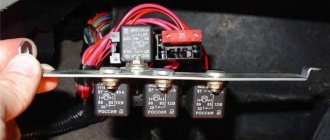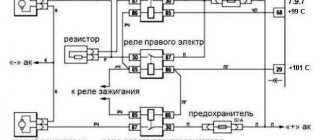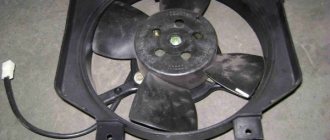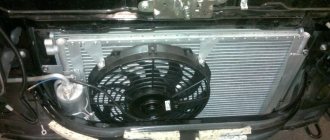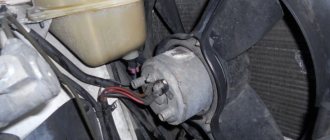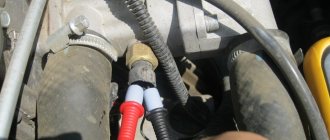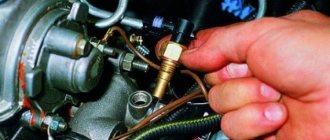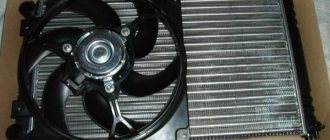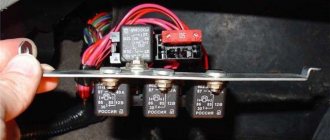VAZ-2110 car owners often encounter the same problem - the cooling fan refuses to work. This phenomenon is not uncommon, and in this case it is not necessary to immediately contact a service station and overpay money to solve this problem.
You can perform all troubleshooting measures yourself. We will tell you the features and recommendations regarding such work later in the article.
VAZ 2110 engine operating temperature
Normal operating temperature of internal combustion engine: +90. +95, if above +97 then the internal combustion engine will be slightly dulled, but this t is also considered normal, up to +110 is also normal, but the radiator fan should already turn on. If t is below +90, this is not overheating. We look at the thermoelement for grinding into the thermostat cover (so that when closed it does not etch into a large circle) and the serviceability of the thermoelement itself by boiling it in the thermostat cover. If the lower pipe is cold, this is not a fact that it does not poison the large circle.
I purchased a 6-hole thermostat assembled, sealed, with an Quality Control Department stamp, t 85, PRAMO, for 505 rubles. I also had a thermocouple from a viburnum, also at t 85, lying around for a long time. ___________________________________________
Kalinovsky thermoelement: ___________________________________________________
Thermostat with thermocouple: ___________________________________________________
I boiled both thermoelements in this one housing of the new thermostat, the result:
1. Thermoelement from viburnum: opened slightly at +92 (began to let water through at atmospheric pressure) at 96 opened slightly by 5 mm +100 opened by 8-9 mm diluted the water to +83 - almost instantaneous slamming.
2. Stock thermocouple Pramo: opened slightly at exactly +85 and went at atm. pressure +86 hole mm 2-3 +88 hole approximately mm 5 diluted the water to +83 - it slows down for about a minute.
Now do you understand why your operating temperature in winter is +88 and below?
There was a thermoelement left from the new PRAMO thermostat, which turned out to be a little longer (rod) and did not fit tightly into the cover of the Priora thermostat. The cover of the Priorov thermostat was drilled out a little and the thermoelement sat tightly, now it is not blown through. (before these actions I thought about it, I didn’t sit down by two mm)
via FTP video 5:52, 24.4 MB _______________________________________________________________
And now the sea trials of the Kalina thermoelement with the Pramo cover:
In weather -15, VideoAdded t coolant on the move, t air in the driver's compartment, t air flow at the carrier's feet (16.6 MB)
Via FTP, 16.6 MB ________________________________________________________________
Warming up from a cold start, with on. stove, -16 on the street, -15 coolant, -15 in the cabin, at XX, 24 minutes: here is the video, 63.4 MB:
Warming up from a cold start, with off. stove, -19 on the street, -18 coolant, -17 in the cabin, at XX, 23 minutes: here is the video, 30.4 MB:
The procedure for repairing a stove fan
- Disassemble the heater motor. First remove the impeller, then the spring clips.
- Deprive him of support.
- Remove the brush assembly by unscrewing the screws first.
- Carefully knock out the rotor.
- Remove dust and dirt from all elements of the heater motor.
- Release the bearing by bending the edges of the plate on the inside of the stator.
- Remove the old bearing #609 and install the new one.
- Fold back the edges of the plate.
- Assess the condition of the plate after this procedure and sand the edges if necessary.
- Remove the old brushes along with the wires. In their place, solder the wires from the new brushes.
- Bend the brush spring stops to easily return the brush assembly to its place. Set it aside.
- Replace the heater motor rotor.
- Reinstall the brush assembly, making sure that the brushes are in their rightful places.
- Fill the gaps with springs and return the stops to their original position.
- Reinstall the impeller.
- Reconnect the electric motor to the stove network.
The fan does not turn on
There may be several reasons for this:
- Fuse. In the mounting block, fuse F7, rated 20 amperes, may be faulty - it is responsible for powering the electric fan and sound signal circuits;
- Thermostat. The liquid circulates only in a small circle, the radiator and sensor do not heat up, and accordingly, the fan does not turn on. You can check by simply probing the pipes; those connecting to the radiator should begin to warm up after opening the thermostat;
- Sensor. For a VAZ 2110 with a carburetor, the contacts are closed for testing; if the device malfunctions, the electric fan will turn on. The connector of the injection motor must be disconnected; with the remaining elements working, the ECU will detect a break in the circuit and issue a constant alarm signal to the relay, which will forcibly turn on the electric motor for cooling;
- Cooling system fan relay for VAZ 2110 injection engines. The sensor is turned off and the power contacts on the relay located in the additional fuse box are closed. If everything works, then we check the control winding: on one contact there is always a positive from the main relay, connecting the second to the body, we try to hear the operation click. But it’s better to simply replace the relay for testing, temporarily, with a known good one;
- Electric motor. During testing, the connector is disconnected; to force the impeller to turn on, voltage is supplied directly from the battery.
If all the elements are working properly, then you need to look for a break in the wires, “ringing” them one by one. Poor contact of the relay and sensor connection wire terminals with the car body is also possible. The worst case scenario would be an ECU failure, in which case the signal from “leg” 46 usually “floats” and does not reach the values of +12 volts (off) and 0 (on).
Fan connection diagram in carburetor and injection engines
The control of forced radiator airflow in carburetor and injection engines of the VAZ-2110 is significantly different. Firstly, the fan switch located on the radiator housing is responsible for everything. It is set to a certain coolant temperature. Usually it is 105-107 o C. The fan does not work, the stove on the VAZ does not heat, why does the “stove” of the VAZ-2110-2112 not heat. When the coolant heats up to this temperature, the sensor is triggered, sending a signal to the fan relay. It closes the electrical circuit, driving the electric motor.
Turning on the cooling fan of a VAZ-2110 with an injection engine occurs somewhat differently. In engines equipped with an electronic control unit, there is no sensor on the radiator. Heater fan, (Ford Mondeo) if the fan does not work at all speeds. Its place was taken by a temperature sensor located on the thermostat pipe. When the coolant heats up to a temperature of 105-107 o C, it sends a signal directly to the controller, which makes the decision to turn on the fan. It transmits an electrical impulse to a relay, which turns on the electric drive.
We recommend: Bendix starter diagnostics and DIY repairs
Thermostat
Many modern cars are equipped with thermostats with sensors. This allows you to more efficiently manage the cooling system. But such management has its drawbacks. In particular, when the system breaks down, various “miracles” can begin. If the sensor installed on the thermostat fails, the fan will run constantly. The reason for this is the following. The control unit, not receiving signals about the operation of the thermostat, goes into emergency mode. At the same time, just in case, the fan turns on; in case of such an error, it will work constantly.
Checking the sensor is quite simple. Like any temperature sensor, in normal condition, it should show infinite resistance when the engine is cold, in all other cases it should show from 100 to 500 ohms. If the check shows different readings, it is better to replace the sensor. Fortunately, it is quite inexpensive.
Air temperature sensor
. Some modern cars are equipped with additional oncoming flow temperature sensors. That is, they react to the ambient temperature. If the indicator specified in them is exceeded, they give a command to turn on the fan. This is done to increase the cooling efficiency of the motor.
This scheme is often found on foreign cars that have sandwich radiators consisting of 3 layers. In this case, the fan will work almost all summer even on a cold motor. It is not recommended to disconnect the sensor; this may lead to engine overheating.
Control circuit modernization
This problem can be solved in two ways: adjust the switch-on temperature in the “brains” or make a button. We'll focus on the second one. Turning on the fan from the button is very convenient: if you get into a traffic jam, turn it on, drive out, turn it off, and no overheating occurs.
A button for selecting the fan operating mode was installed in the cabin (always off, constantly on, automatically turned on via a sensor) - this “tuning” is not mandatory, but will be a very useful addition.
There will be a large current at relay contacts 87, 30, on the wire from the battery to the fuse and the fan ground, and therefore we must use wires there with a cross-section of at least 2 mm, otherwise the thinner wire will not withstand it and will burn out.
Possible malfunctions and ways to eliminate them
The following symptoms may inform the car owner about the failure of the DVT:
- The quality of the exhaust gases is too low, which is associated with a violation of the combustible mixture in the cylinders.
- Fuel consumption has increased, and noticeably.
- Problems have arisen in the operation of the power unit. The dynamics of the vehicle may decrease, and the engine power as a whole will also deteriorate.
- Combinations of errors may appear on the dashboard, and the ECU may also send a signal to the dashboard about the need to check the performance of the motor.
- The power unit has become more difficult to start.
When they detect the first signs of problems, many motorists immediately drive their car into a garage or service station to change the controller. In practice, symptoms of DTOZ malfunctions are often associated with damage to the electrical circuit and poor contact of the device with the vehicle’s on-board network. Therefore, if you encounter a similar problem, we first recommend checking the condition of the wiring.
Photo gallery “Diagnostics of DTOZH”
1. DTOZH connected to a multimeter in a container with antifreeze
2. Dependence of temperature (left), resistance (right)
Quick Repair Methods
If the thermostat has died for a long time on a long journey, then first try knocking on its body. Sometimes, after exposure, the valve opens, but expect it to jam again soon. The best option is to drain the fluid and try to break through the thermostat to turn on the big circle. And if suddenly there is a new one or a working one in the glove compartment, then install it.
It’s more difficult with a pump on the road; it will be easier to add water as needed. But this is only if the leak is not very large. Having reached the place where repairs can be carried out, it needs to be replaced. On sevens this is done quite quickly, you just need to drain the liquid, loosen the fan belt and remove the old pump. And on nines you will have to remove the casing that covers the timing block, loosen the belt, and only then use a 10mm wrench to unscrew the three bolts securing the pump.
But with a fan everything is simpler. If there is a breakdown in the sensor, then the easiest option is to short-circuit its contacts. In this case, the fan will work constantly, so after stopping the engine, be sure to turn it off, as the battery will run out. If the problem is in the wiring, then the best way to get out of this situation is to connect a fan to the battery. But if the electric motor winding burns out, then only a complete replacement will help.
- Description of the VAZ 2107 cooling system
- Typical failures in the cooling system in 2017
The engine cooling system is one of the important parts of the car. It not only cools the engine, but also heats the car interior in winter. And to carry out maintenance and repair, you simply need to know the composition of the system and the general principle of its operation.
The first copies of VAZ 2110 cars were practically a copy of the nines. The only difference is in the body, but the engine and gearbox are similar. But carburetors were replaced by an injection system, and a lot has changed in the car, including the cooling system. Constant modernization makes itself felt, the car becomes more reliable, but more difficult to maintain. Of course, increasing engine power entails a lot of modifications. Changes occur in the braking system, lubrication and cooling systems. But the operating principle remains virtually unchanged.
Checking at home
Sometimes the electric motor turns on too late, when the antifreeze temperature is already high. This may be caused by a malfunction of the valve in the radiator cap or abnormal parameters of the switch on sensor. You can check the device’s response temperature at home using a multimeter and thermometer.
After disconnecting the electrical connector, the sensor is unscrewed with a key. To avoid burns, remove the device only from a cold engine, after draining the antifreeze. When reinstalling, it is advisable to use a new sealing copper washer and not apply too much force when tightening.
The switching temperature is engraved on the end; it can be from 92 to 95 degrees. To check, you need to connect the multimeter in resistance measurement mode and immerse the threaded part in a container of water.
While heating the water and monitoring the readings of the multimeter, we use a thermometer to record the moment it turns on, and when it cools down, the temperature it turns off. Standardly, these are 92 and 87 degrees; with significant deviations, late operation is especially critical, the device requires replacement.
To improve cooling, it is possible to install a double fan from Niva. There are two modifications for placement: after the radiator or in front of it.
Nivovsky injection radiator 21214-1300024-43 (placed in front of the radiator)
On the VAZ 2110, any of the options can be installed with minimal modifications to the fasteners on site. When electric motors are connected in parallel, the current consumption increases to 40 amperes, which requires replacement of the wiring.
Nivovsky suction radiator (placed after the radiator)
Monitor the engine temperature. If you notice overheating too late, then in addition to boiling of the antifreeze and a forced stop, more serious consequences are possible: deformation of the cylinder head, jamming of the camshaft. If there are defects in the operation of the cooling system fan of the VAZ 2110, the faults can be diagnosed independently by checking the thermostat, electric motor, relay, and switch sensor.
How to check the heater damper micro-reducer
To test the micro gearbox, you must use an ohmmeter. On older versions of SAUO controllers, the minimum resistance should be in the range from 800 to 1,200 Ohms. In new samples this figure is 3.5–5 kOhm. Set the minimum mark on the heater control unit and wait 15 seconds. Next, simply disconnect the controller connector, measure the resistance between contacts X1.4 and X1.1.
When the temperature is set to the maximum level, the multimeter should output 3.2–5 kOhm, taking into account the fact that an old version of the controller is used. On the new one the indicator is 1.2–1.6 kOhm. If the indicators do not change, it means that the micro-gearbox shaft position sensor on the VAZ 2110 is faulty. In this case, take the car to a service center, as the replacement process requires the intervention of a professional. If you want to carry out the replacement yourself, carefully follow safety precautions.
Replacing the cooling fan and radiator on VAZ 2110, VAZ 2111, VAZ 2112
The engine cooling fan plays a very important role, since it cools the radiator, which in turn circulates coolant through the system and all of this together is a cooling system, but the fan sometimes fails, and the radiator sometimes gets punctured by pebbles, which causes it to start Coolant leaks and it needs to be replaced.
We recommend: Replacing Lada Priora headlights (VAZ Priora)
Note! To replace both of these units, you will need to stock up on: Wrenches, as well as a socket wrench, in addition, you will need a small container (it should be wide) into which you will drain the coolant from the radiator of the cooling system, and you will also need a screwdriver!
Where are the radiator and cooling fan located? Both of these units are located in the front of the car, you won’t be able to see them so easily, because they are large and therefore you can only see parts of them, for example, to see the fan you will only need to look under the TV of the car (The TV is its front part on which the headlights, bumper and other parts are located, the wings no longer belong to it) and you will see a fan thanks to which the car’s engine is cooled (For clarity, the fan is indicated by a red arrow, and the air filter housing has already been removed since it is very in the way review), and in order to see the radiator itself, you can also look under the same TV or look through the radiator grill (The radiator will be visible through it).
When do you need to change the radiator and cooling fan? The radiator, as mentioned earlier, needs to be changed when a hole or holes appear on it, which may appear due to a pebble getting into it (this happens through the radiator grille) or due to strong pressure in the cooling system, which may appear due to a valve malfunction in the cap of the expansion tank or in the radiator cap, if these valves or only one valve fails, the pressure in the system increases, and therefore the increased pressure in the expansion tank (Tank cap valve has failed) will ultimately lead to the fact that the tank is in in the literal sense of the word, it will explode, as for the radiator relief valve, it is still located on the same cap (On the radiator cap we mean) and when this valve fails, the pressure in the radiator begins to increase, and therefore it begins to leak from all the cracks of the radiator The fluid and radiator will eventually (if you drive at high pressure for a very long time) become unusable.
Note! To prevent this from happening, change the radiator cap and the expansion tank cap once every year or two, buy these things after making sure that the valve works, and then in the future you will have fewer problems with this! (For information on how to check the functionality of the expansion tank cap valve, see the video below and always remember this thing: the valve must keep the pressure within 1.1 - 1.5 kgf/cm2 and then the cap can be said to be working properly)
A couple more words about the radiator, in fact, you can check whether there are holes in it or not, they are just usually small and it can be quite difficult to notice them, so in order to find them they use a very cunning method, which is as follows: Take the radiator and all the pipes that go from it and on which the hoses are put on are closed with plugs (you can close them with anything, the most important thing is to make the radiator sealed so that no water gets into it) and then lowered into water (in the bath is easiest), after Once the radiator is in the water, figure out how you can pump air into it, after you come up with an idea, supply air to the radiator at a pressure of 2 kgf/cm2 (You can pump this pressure into the radiator with a compressor, or you can try with a regular pump) and after that you will immediately you will see whether there are holes in the radiator or not (If there are, then air bubbles will come out from there), for clarity, how to check the radiator for serviceability, look at the video clip located just below:
Note! If the holes are small, then buying a new radiator does not make any sense, because small holes can be closed, for example, using a special substance that is sold in a car shop and which will need to be moved with coolant, this substance will clog into the hole and thereby prevent the penetration of liquid through it, also a not very large hole in the radiator can be removed by soldering or welding, but we do not recommend that you remove large holes, so in this case it is better to go to an auto store and buy a new radiator!
How is the fan connected?
Depending on the type of engine, the operation of the fan is controlled by different means. If the engine has a carburetor, then the operation of the device is controlled by a TM-108 thermobimetallic sensor located on the radiator body (if you look in the direction of travel, it is on the left side). In many VAZ cars, the sensor responds to the maximum antifreeze temperature (107 °C). With this value, the sensor immediately sends a control signal to the fan relay, and it begins its operation. But what should you do if the cooling fan on a VAZ-2110 with an injector does not turn on?
On VAZ-2110 vehicles equipped with injection power units, the operation of the fan is controlled by a controller, but a sensor is also present. It is located near the thermostat. When the antifreeze reaches its maximum temperature, the sensor sends a signal to the computer, which turns on the fan via a pulse on its relay.
Design Features
The cooling system, as a rule, consists of a large number of components. In a situation where the fan is not working, we will need to be aware of the following components:
- Actually an electric fan, which is triggered when the antifreeze heats up to a temperature in the range of 100-105 degrees.
- Fan trigger sensor. This unit is configured from the factory so that the device begins to operate under specifically established conditions. The sensor is fixed on the inlet pipe of the cylinder block. The housing is marked with the following code: LS0112.
- Fuse F7, located in the mounting block.
- Fan relay. The component is located in the cabin under the right dashboard panel.
If the fan itself on your car does not work, then carefully check all of the above components of the cooling system. However, there are times when one situation will not be related to the breakdown in question.
Why does the fan on the VAZ not work?
- - flat screwdriver;
- - side cutters or pliers;
- — wire with a cross-section of at least 0.75 sq. mm in insulation;
- - insulating tape;
Take your car's electrical diagram and find the components responsible for controlling the electric fan. First of all, check the integrity of the electrical fuse
Please note that older cars did not use an electric fan; instead, an impeller was installed on the pump, which rotated constantly. This type of radiator airflow is good because it provides better cooling in hot weather.
But in cold weather, the engine takes longer to reach operating temperature, so you have to cover the radiator with cardboard or a piece of plastic in the winter.
Check the functionality of the temperature sensor installed in the radiator housing. An electric fan may not turn on due to a failure of the sensor, which is a simple switch whose contacts close at a certain temperature. After a little reflection, we can come to the conclusion that by closing the contacts of this sensor, we will force the electric fan to turn on. Looking at the simplest control circuit that is used on VAZ cars, you can see that the sensor is installed in the break of the fan power wire.
Check the functionality of the electromagnetic relay if the fan switching circuit is relay. This can be done by closing the relay contacts connected to the sensor. There should be a faint click, indicating that the coil is intact. But do not forget that voltage should appear at the positive terminal of the fan. If it is not there, then it is quite possible that the relay contacts are damaged. When opening and closing, a small spark is formed, which can even melt the contacts. Therefore, after checking the coil, be sure to short-circuit the power wires. Just do not short the positive wire to ground.
Take a wire with a cross-section of at least 0.75 square meters. mm to connect an electric fan to the battery terminals. This decision will be correct if the breakdown cannot be quickly diagnosed. As a rule, diagnostic complications occur when the electrical wiring is broken. For example, on cars of the eighth family, the temperature sensor is not connected to ground at the closest point, but the wire is stretched under the radiator and goes to the fuse box. In order not to boil in a traffic jam, the best solution is to open the plug connection and connect the fan to the battery. Just do not reverse the polarity, otherwise the engine will rotate in the opposite direction and the radiator will not cool down as a result.
An electric fan motor is a DC machine that is polarity sensitive. When connected to a battery, the motor will rotate incorrectly in the opposite direction.
checking the cooling system on a VAZ 2108, VAZ 2109
Fan connection 2108, 2109, 21099
Until 1998, on cars with the old mounting fuse block 17.3722 (finger type fuses), relay 113.3747 was included in the fan circuit. After 1998 there is no such relay.
Also, before 1998, the TM-108 switching sensor was used (the closing temperature of its contacts is 99±3ºС, the opening temperature is 94±3ºС), after 1998 the TM-108-10 with similar temperature ranges or its analogues from different manufacturers. The TM-108 sensor only works in conjunction with a relay; the TM-108-10, reinforced for high current, can work both with and without a relay.
Scheme for switching on the engine cooling fan on a VAZ 2109 with mounting block 17.3722
- Fan motor
- Motor start sensor
- Mounting block
- Ignition switch
K9 - Relay for turning on the fan motor. A - To terminal “30” of the generator
Scheme for switching on the engine cooling fan on a VAZ 2109 with mounting block 2114-3722010-60
- Fan motor
- Sensor 66.3710 for turning on the electric motor
- Mounting block
A - To terminal “30” of the generator
Fan operation temperature VAZ 2112
Probably, many have noticed that the fan switching temperature on the latest generation VAZ 2110 -2112 engines (100-105 C) is too high compared to the normal operating temperature of the engine (85-90 C).
First of all, this introduction is connected with the manufacturer’s struggle for cleaner exhaust from the pipe of your car (requirements of modern Euro 3 standards and higher). At this temperature, more complete combustion of the fuel and its components occurs.
But it should be noted that, as always, a given positive side for one aspect brings something negative for another. So, with a slight, but still overheating of the engine and head, irreversible physicochemical processes occur in the metal, which ultimately affects the overall final operation of the engine hours of the power unit. Apart from the fact that in the event of a failure of the electrical components that affect the fan’s activation, the time to notice this at an elevated standard switching temperature of 105 C to overheating of 125 C will be significantly less than from normal operating temperature to overheating. So it depends on people... let’s say it turns on at different temperatures... it’s 100 or 110 degrees) I don’t deny that the instrument panel itself may be lying) but I think it’s better to play it safe and make a chip tuning to turn on the fan, let’s say 98 degrees or stupidly remove the button to the fan)
PROBLEM SOLVED) I SCREWED THE ADDITIONAL MOUNT FROM THE GENERATOR TO THE BODY) AND EVERYTHING FOUND INTO PLACE) THERE IS NO LONGER VOLTAGE DROPS))) AND ON THE INSTRUMENT PANEL, THE FAN ACTIVITY INSTRUMENT BEGAN TO SHOW 98 AS IT SHOULD BE)
Many motorists, when operating the 16-valve VAZ-2112 engine, encountered the fact that the engine simply boiled. This is due to the engine overheating. What is the operating (normal) engine temperature? In this article, we will consider what temperature should be in the power unit and its systems, as well as the reasons and methods for solving an increase in this indicator.
Common faults
Since the fan is spinning, it needs to be forced to stop and turn on only when there is a real need for it.
There are several main reasons why cooling system fans may turn on when the engine is cold. This is related to:
- switch on sensor;
- coolant;
- mass;
- thermostat;
- temperature sensor;
- contacts;
- air conditioning.
Each of the points may be the reason why the fan turns on and starts rotating when the engine is cold.
Power sensor
One of the most common reasons why a fan runs on a cold engine is a short circuit in the controller, that is, the sensor.
Quite often it happens that the fan starts when the ignition is turned on. If this occurs at the same time, the contacts on the controller have probably shorted. As a result, the airflow works constantly.
Although the breakdown is the most common, it is also the most harmless and safe. The worst consequence of this phenomenon is considered to be a complete discharge of the battery. This will happen if you leave the ignition on for a while.
To check whether the short is at fault or not, you will need to use a multimeter to check the resistance by applying probes to the terminals. When the sensor is working, the multimeter shows infinite resistance, that is, it displays the corresponding value on the display.
If you see that the resistance is less, then the contacts are probably closed. The controller will need to be replaced. Such a malfunction is displayed as a separate code during computer diagnostics.
Coolant
Sometimes there is no need to look for all sorts of reasons why the cooling fan suddenly turns on on a cold engine. Experienced motorists advise starting with a simple check of the coolant.
The thing is that quite often the sensor reacts by activating the fan to a lack of coolant in the system. The amount of antifreeze that is available heats up too quickly, which leads to the fan starting when the engine is still cold.
Therefore, it is not so rare that the cause of such a malfunction is the banal inattention of the car owner. Some drivers simply forget that they need to monitor the fluid level and periodically add fresh antifreeze to the expansion tank. It will gradually evaporate, so reserves need to be replenished. When the radiator is half empty, the sensor will indeed begin to react accordingly. To cool the motor, it will use air cooling, implemented using a fan.
Due to a shortage of cooling liquid, it heats up faster than with a completely filled system. And the coolant temperature does not match the engine temperature. As a result, it turns out that the engine has just been started, it has not yet warmed up, and the fan is already rotating its blades at full speed due to the high temperature of the quickly warmed up liquid.
Expansion tank cap
The last reason why the VAZ-2110 cooling fan may be a malfunction of the expansion tank cap. The fact is that when the engine is running, a pressure above atmospheric pressure is created in the cooling system, due to which the water, which is part of the coolant, does not boil at 100 o C. The expansion tank cap valve is designed to maintain the required pressure. If it fails, the pressure in the system will be equal to atmospheric pressure. The cooling fan on the VAZ 2112 does not turn on. This will lead to the coolant starting to boil already at 100 degrees. A sensor designed to turn on at a higher temperature will naturally not work.
It is unlikely that you will be able to check the operation of the cover at home, so if during a visual inspection you have doubts about its functionality, it is better to replace it immediately.
Procedure. Step-by-step instruction
If after completing the next step the problem goes away, further checks are stopped.
- Open the hood.
- Wait for the engine to cool down.
- Perform an initial visual inspection: integrity of the hoses, reliability of the clamps, absence of leaks or cracks.
- Make sure that the expander cover elements are in good condition. Remove scale, rust, clear holes, wipe, assemble. The absence of noticeable damage to parts gives hope that the product will work.
The valve design is elementary. The cover contains a spring. Functionally, it is designed to regulate the pressure in the cooling circuit. A hot engine increases it, a cold engine decreases it.
Compressing at a value of 1.1 atmospheres, the spring relieves excess pressure and prevents the destruction of hoses and the tank. As the motor cools, it creates a vacuum effect. The tank will begin to flatten. The valve equalizes the pressure.
The lid screws tightly on the thread, eliminating distortions. There should be a gap between it and the body. An overtightened valve will not work. It is difficult to test the device's operation in road conditions. You can check by replacing it with a known good one.
Inspect the electrical wiring elements to ensure a reliable connection
Possible factors for damage to electrical circuits:
- vibration;
- oxidation;
- burning;
- breakage, fraying of electrical wires;
- insulation aging, short circuit.
Switch the tester to resistance measurement mode. Remove it with special tweezers and ring the fuse link F7 located in the mounting block.
Replace the burnt-out element with a serviceable one with a rating of 20A. Inspect and clean the nest. Insert fuse.
It was not possible to find out the reason, the protection triggered again - look for a short circuit.
Disconnect the fan plug. Use a tester to measure the circuit of the electric motor windings. Zero resistance or a break indicate the need to replace the radiator blower electric drive.
Interturn short circuits that cause multiple replacements of fuse links cannot be measured with the device.
Sensor check
Start the car. Pull out the coolant temperature sensor connector. The fan starts working - the sensor needs to be replaced. Secure the disconnected wire. Drive to a nearby service station.
Relay test
There is a hatch on the floor at the front passenger's feet.
Below it is a built-in panel with three relays of the same type:
- fan installation;
- fuel pump;
- ignition (main thing).
By replacing each other, try to start the airflow. The VAZ 2110 fan does not work - go to the next step.
Where is the VAZ 2110 cooling fan relay located?
If you are wondering where the fan relay is located on a VAZ 2110, then this photo below will answer your question and you can easily find where the cooling fan relay is located on a VAZ 2110.
Check the electric motor
Winding measurements did not reveal a malfunction. Apply voltage briefly from the battery using additional insulated conductors. The operation of the fan indicates a malfunction of the controller, which does not output a signal to the relay.
- The only correct solution is to turn on the airflow directly and urgently visit a service station.
- Prevention of breakdowns of the cooling system of the VAZ 2110 injector 16 valves.
- Periodically inspect the components of the cooling system.
- Monitor the cooling temperature on the device, listen to the operation of the fan.
- Maintain coolant level. Replace after 2 years or 30,000 km.
- Use the solution to remove rust and scale.
- Signs of a change in the properties of the coolant are a change in color, an increase in fluidity.
- Check the density with a hydrometer.
- Do not mix coolants.
- Every twelve months, rinse the expansion tank cap with water and check it on a stand with a pressure gauge.
- Avoid contact of aggressive liquids with electrical wiring and electric motor windings.
Improvements to the fan start control circuit for the VAZ 2110 injector
The smooth functioning of the engine worries factory designers, auto mechanics, and car enthusiasts. Folk craftsmen change the design of valves and electrical circuits.
Installation of three position toggle switch:
- continuously on: the VAZ 2110 cooling fan does not work;
- constantly switched off: warming up the engine when starting in the cold season, automatic control is faulty;
- automatic mode: controlled by the controller, the equipment is working properly, the algorithm is executed correctly.
When choosing an installation location, consider the following conditions:
- prevent accidental switching;
- not to be confused with other controls.
It is important to remember when modifying the design about the safety of the changes made.
Constant fan operation
This phenomenon, although rare, does occur. The reasons for the constant operation of the fan in this case may be a relay that is in a closed state or a broken wire of the device. To eliminate the breakdown, it is enough to replace the faulty element.
As you can see, you can independently diagnose and determine why the cooling fan does not turn on on a VAZ-2110 with an injector. The malfunction can be easily identified by checking each element, but there may be difficulties. In this case, you should contact specialists or start all over again. The final choice is always up to the owner of the car.
Source
Safety valve
Knowing physics, you will agree that at normal atmospheric pressure, the water that is part of antifreeze boils at a temperature of 100 degrees Celsius.
Old device
If the VAZ 2110 cooling fan fuse, that is, the valve located on the expansion tank cap, turns out to be faulty, and there is atmospheric pressure inside it, the cooling liquid will boil, but the fan will not be able to start working even with a working electrical circuit. This is because the fan switching sensor on the injection VAZ 2110 has a switching temperature of more than 100 degrees Celsius.
To fix this problem, replace the expansion tank cap. The new element must maintain the pressure inside the system above atmospheric pressure, which will allow the laws of physics to work, the boiling temperature to rise to 105 degrees Celsius and thereby turn on the blades of the unit.
Operating principle and triggering requirements
So, the main element of the DVV is the contact group inside the node. When the desired temperature is reached, the sensor contacts begin to expand and at a certain moment close. After this, the signal goes to the ECU, which, in turn, gives a command to the fan.
What should the switch-on temperature be? You must remember that DVVs are available with different temperature limits.
Most often, switching on occurs when 92 degrees Celsius is reached, and switching off occurs at 87. Sensors are also sold with other temperature ratings, but for the VAZ-2110 the 92/87 option is most suitable - so give preference to it.
Confinement of mass
The functioning of the fan depends on different methods, as you have already seen from reading this article. There is another reason that disables the fan's performance. For example, if the corresponding wires are poorly screwed to the body, the fan is connected directly to the battery. It should be noted that in this case, it is necessary to take timely measures to avoid serious problems.
With this option, you can expect the car to catch fire. If a strong short circuit occurs, then all the wires will heat up accordingly. To avoid serious consequences, you should check the connections and wires that have access to the sensor. Reliable fastening of wires and intact insulation reduces the risk of serious consequences.
